疲れた脚がスキーを台無しにしていませんか?解決策は短いスキーです。 軽量でコントロールしやすく、長いスキーに比べて筋肉への負担が少ないです。初心者でも上級者でも、short skisのSnowfeetモデルなら、疲れを感じずに長く滑れます。
なぜShort Skisが効果的なのか:
- 負担軽減:短い長さで膝や脚へのストレスを減らします。
- 扱いやすい:素早いターンと優れたコントロールで疲れにくい。
- 携帯に便利:バックパックに収まるコンパクトサイズ。
- 特別なブーツは不要:一部のモデルは普通の冬用ブーツで使えます。
Snowfeet オプション:
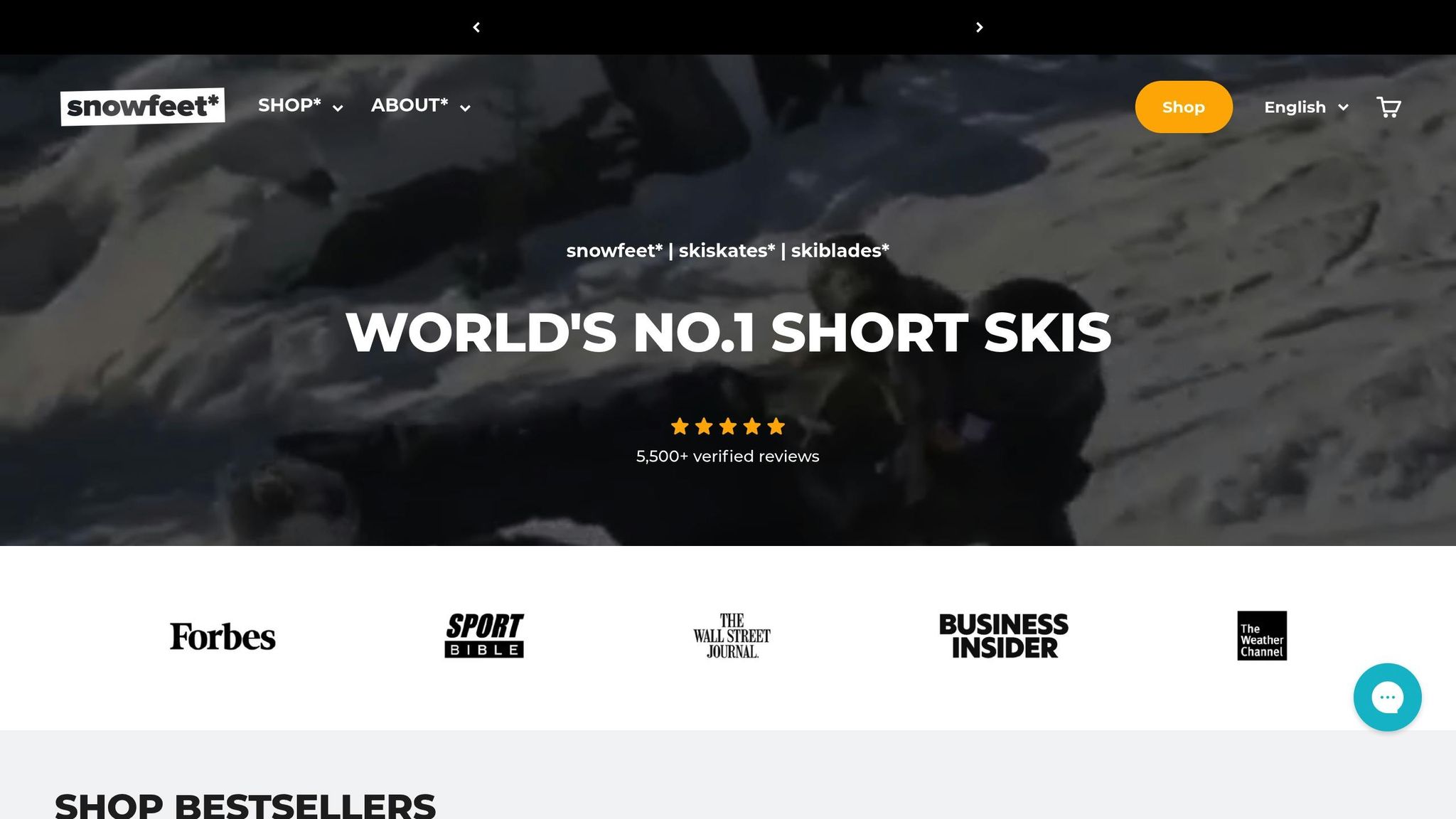
- Mini Ski Skates (38 cm):初心者やカジュアルな楽しみに最適。
- Skiblades (65–99 cm):カービングとトリックにぴったり。
- Short Skis (120 cm):多用途を求める上級スキーヤーに最適。
| モデル | 長さ | 価格 | ブーツ | おすすめ |
|---|---|---|---|---|
| Mini Skates | 38 cm | 150ドルから | どんな冬用ブーツでも | 初心者、ハイキング、楽しみ |
| Skiblades | 65–99 cm | $450–$490 | スキー/スノーボードブーツ | トリック、カービング、パーク |
| Short Skis | 120 cm | $690 | スキー/スノーボードブーツ | 上級者向け、オールマウンテン |
結論: 長くスキーを楽しみ、脚を守りたいなら、短いスキーが最適です。あなたのスタイルとスキルレベルにぴったりのモデルを見つけるために読み進めてください。
ショートスキー vs. ロングスキー
Snowfeet*のようなショートスキーが伝統的なスキーに勝る理由
Snowfeet*のショートスキーを、Rossignol、Atomic、Headなどの伝統的なスキーと比べると、その違いは明らかです。伝統的なスキーは通常150〜180cmですが、Snowfeet*製品は38cm(ミニスキースケート)から120cm(ショートスキー)まであります。サイズにこだわるのではなく、Snowfeet*は快適さと使いやすさに焦点を当てています。実際にどのように際立っているかをご覧ください。
軽量で持ち運びやすい
Snowfeet*の最大の魅力の一つは、その軽さとコンパクトさです。従来のスキーはかさばるバッグやルーフラックが必要なこともありますが、Snowfeet*のショートスキーは持ち運びがとても楽です。例えば、ミニスキースケートはわずか38cmでリュックにすっぽり入ります。65cmのスキーブレードも車のトランクに簡単に収まり、場所を取りません。この携帯性のおかげで、ギアの持ち運びの手間が減り、ゲレンデでの時間が増えます。
簡単なコントロールと動き
ショートスキーは持ち運びが便利なだけでなく、山での操作も簡単です。コンパクトなサイズでターンや操作がとても楽になり、小さな動きにも素早く反応します。従来の長いスキーでは、ターンを決めるには強い脚力と正確な技術が必要ですが、Snowfeet*はそれを簡単にします。Snowfeet Teamの専門家の一人はこう言います:
"長いスキーと比べて、ショートスキーは明らかに軽く、持ち運びやすく、習得も簡単です。" - Snowfeet Team
このデザインは自然な姿勢を促進し、膝や腰への負担を軽減します。長いスキーのように不自然な姿勢を強いることなく、Snowfeet*は短く鋭いターンを少ない力で可能にします。整備されたコースをカービングしたり、モーグルに挑戦したり、疲れを感じずに長く滑れます。
どんな冬用ブーツでも使える
もう一つのゲームチェンジャー?Snowfeet*は普通の冬用ブーツ、スノーボードブーツ、またはスキーブーツで使えます。専門的なスキーギアは不要です。従来のセットアップは特定のブーツやビンディングが必要で、不快で疲れやすいこともあります。Snowfeet*なら、フィットして一日中快適な履物を選べます。このシンプルな柔軟性が疲労を減らし、山での時間をより楽しいものにします。
Snowfeet Teamのメンバーが説明します:
"レクリエーションスキーの目的には、ショートスキーの方が優れています。持ち運びやすく、好きな履物を選べて、何よりも乗りやすいので、疲れ切って終わることはありません。" - Snowfeet Team
あなたのニーズに合ったSnowfeet*モデルの選び方
適切なSnowfeet*モデルを選ぶには、それぞれのオプションが何を提供し、あなたのスキーのスタイルにどう合うかを理解することが重要です。従来のスキーが主に長さで異なるのに対し、Snowfeet*モデルは特定の用途とスキルレベルに合わせて設計されています。各モデルの特徴を分解して、あなたの冒険に最適な選択をしましょう。
Snowfeet*モデル比較
Snowfeet*は、さまざまなスキーの好みに合わせたモデルを提供しています。こちらが利用可能なモデルの概要です:
- Mini Ski Skates:コンパクトな38 cmのスケートで、基本のSnowfeet*(150ドルから)、Snowfeet* II、Snowfeet* Xの3バージョンがあります。どんな冬用ブーツにも対応し、米国の靴サイズ6〜13にフィットします。基本モデルはコストパフォーマンスに優れ、Snowfeet* IIはエッジとバインディングがアップグレードされています。Snowfeet* Xはより強力で調整可能なバインディングで耐久性を追求しています。
- Skiskates:44 cmで、木製コアを持ち、スキーまたはスノーボードブーツと一緒に使うのに最適です。斜面向けに設計されており、Mini Ski Skatesよりも高性能な体験を提供します。
- Skiblades:65 cmと99 cmの長さで、遊び心のあるトリックから斜面のカービングまで完璧です。短いバージョンは操作性が高く、長い方は安定性を提供します。
- Short Skis:120 cmで、伝統的なスキーの感覚をよりコンパクトなデザインで提供し、多用途を求める上級スキーヤーに最適です。
| モデル | 長さ | 価格 | ブーツ | おすすめ |
|---|---|---|---|---|
| ミニスキー スケート | 38 cm | 150ドルから | どんな冬用ブーツでも | 初心者、多用途、ハイキング |
| Skiskates | 44 cm | 390ドルから | スキー/スノーボードブーツ | 斜面、スピード、経験者向け |
| Skiblades | 65–99 cm | $450–$490 | スキー/スノーボードブーツ | カービング、スノーパーク、トリック |
| Short Skis | 120 cm | $690 | スキー/スノーボードブーツ | 上級スキー、オールマウンテン |
疲労を避けるための最適なスキーの長さ
脚の疲れを抑えたいなら、短めのスキーがおすすめです。例えば38 cmのMini Ski Skatesは扱いやすく、長時間のセッションに最適です。イギリスのヴァネッサさんが体験を共有してくれました:
"これは素晴らしいです。頑丈な素材で、この冬は運動にもなり、道で使うのがとても楽しかったです。家族全員でそりの丘や道で使いました。子どもたちも大好きです。"
スキーとスケートの両方を楽しみたいなら、65 cmのSkibladesが堅実な選択です。より安定した滑りとスムーズなカービングを求めるなら、99 cmのSkibladesが適しています。フルレングスのスキー(通常150~180 cm)のかさばりを避けつつ伝統的なスキー感覚を味わいたいなら、120 cmのShort Skisがバランスの良い選択です。
- 短めの長さ(38~65 cm):初心者、軽量の方、素早く機敏なターンが好きな方にぴったりです。
- 長めの長さ(99~120 cm):速いスピード、体重の重い方、オフトレイルの冒険に最適です。
初心者と上級者におすすめのモデル
初心者の方には、Mini Ski Skates(基本のSnowfeet*)が素晴らしい選択です。38 cmの長さで操作が簡単で、特別なブーツも不要なのでとても便利です。アメリカのジョンさんの声をご紹介します:
"まさに私が探していたものです。主にクロスカントリースキーに使っています。とてもよく機能し、整備されたコースでなくても問題ありません。Snowfeet は、雪の自然の中をスキーで楽しみたい私の目的にぴったりです。"
上級者向けには、99 cmのSkibladesがカービングやダイナミックなターンに最適で、Skiskatesは高性能で斜面に対応した体験を提供します。頑丈な作りで伝統的なスキーに近い感覚を味わえ、疲れた脚を気にせずライドを楽しめます。
多くの選択肢がある中で、Snowfeet* はあなたのスキルレベルやスキーの目標にぴったり合うモデルを簡単に見つけられます。初めて雪の上を歩く方も、山をカービングする方も、より楽しく快適な一日を過ごせるよう設計されたモデルがあります。
Snowfeet*対伝統的なスキーブランド:並べて比較
Snowfeet*がRossignol、Atomic、Head、そしてElanのような伝統的なスキーブランドとどう比較されるかを見てみましょう。1日の終わりに脚がふらふらにならないスキーを探しているなら、その違いは明らかです。スピードとパフォーマンスを重視した従来のスキーは、脚や関節への負担が増えるというトレードオフがあります。一方、Snowfeet*は携帯性と操作のしやすさに焦点を当てており、素晴らしい代替手段となっています。
パフォーマンスとコントロールの違い
Snowfeet*の際立った特徴の一つは正確なコントロールです。RossignolやAtomicのような従来のスキーは通常150〜180cm(59〜71インチ)の長さがあります。この長さがレバレッジを生み、膝や関節に余分な負担をかけることがあります。Snowfeetチームは次のように説明しています:
「長いスキーで滑ると関節にかかる力が大きくなり、膝に負担がかかることがあります。」
Snowfeet*は異なるアプローチを取り、Mini Ski Skatesはわずか38cm(15インチ)から、Short Skisは120cm(47インチ)までのモデルがあります。短い長さはターンや方向転換を簡単にします。Snowfeetチームによると、「短いスキーはより操作性が高く反応も良いため、転倒を防ぎ怪我のリスクを減らすのに役立ちます。」
それだけでなく、Snowfeet*のスキーは幅広のプロファイルとしなやかなフレックスを備えており、衝撃や振動を吸収します。これにより脚への負担が減り、全体的に滑らかな乗り心地になります。そして軽量設計も快適さと扱いやすさをさらに高めています。
サイズと輸送の利点
Snowfeet*のもう一つの大きな利点は持ち運びのしやすさです。従来のスキーはかさばり、輸送にはルーフラックや大型のスキーバッグが必要です。一方、Snowfeet*は普通のバックパックに収まるほどコンパクトです。例えば、Mini Ski Skatesは数ポンドの重さで長さはわずか38cm、バッグに放り込んで出かけるのに最適です。最長のShort Skisでも120cmで、標準的なスキーよりはるかに携帯しやすいです。
この携帯性は新しい可能性を開きます。もうリゾートの斜面に限定されず、ハイキングトレイルや地元の丘、さらには自宅の庭でもSnowfeet*を使えます。さらに、雪に触れる前に重いギアを運んで疲れることもありません。
価格比較と価値
ここでSnowfeet*が本当に輝くのは価格です。従来のスキーセットアップは、スキー、ビンディング、専用ブーツを別々に購入する必要があるため、すぐに高額になります。AtomicやHeadのようなブランドの基本セットアップは650ドルから800ドルの間で、高級ギアはしばしば1,200ドルを超えます。一方、Snowfeet*はオールインワンのソリューションを提供しており、Mini Ski Skatesはわずか150ドルから始まります。
| カテゴリー | 伝統的なブランド(Rossignol、Atomicなど) | Snowfeet* |
|---|---|---|
| エントリーレベルスキー | $300–600 | $150(Mini Ski Skates) |
| ミドルレンジスキー | $500–900 | $390–490(Skiskates/Skiblades) |
| ハイエンドスキー | $800–1,500+ | $690(Short Skis) |
| 必要なブーツ | $200–800(スキーブーツのみ) | どんな冬用ブーツでも(Mini Ski Skates) |
| ビンディング | $150–400(別売り) | 含まれる |
| 総エントリーコスト | $650–1,800+ | $150–690 |
初期費用に加えて、従来のスキーは継続的なメンテナンス費用がかかります。ワックスがけ、エッジ調整、ビンディングの調整は1回あたり30~60ドルの追加費用となります。しかし、Snowfeet*はメンテナンスがほとんど不要で、さまざまな雪のコンディションに対応できるよう設計されており、頻繁な専門的なサービスは必要ありません。
Snowfeet* はコスト効率が良く、メンテナンスが少なく、脚にも財布にも優しい選択肢です。最も手頃な Snowfeet* モデルでも、従来のセットアップに伴う負担なしに長く滑るための快適さとコントロールを提供します。
sbb-itb-17ade95
Snowfeet* で脚の疲労を減らすためのヒント
Snowfeet* の体験を最大限に活かすには、賢く使うことが大切です。これらの短いスキーは従来のスキーに伴う負担を軽減するよう設計されていますが、いくつかの賢い調整でスロープでの時間をさらに楽しくできます。正しいアプローチで、嫌な脚の疲れなしに長く滑れます。
適切なギアの選び方
疲労軽減に大きな違いをもたらすのが、適切な Snowfeet* モデルの選択です。トリックやカジュアルスキーが好きなら、Mini Ski Skates(15インチ/38cm)が軽量で動きやすくおすすめです。もう少し安定性が欲しいけど機動性も失いたくないなら、65cmのSkibladesがコントロールと操作性のバランスが良い選択です。
適切なビンディングとソックスの重要性を見落とさないでください。ビンディングはブーツのサイズとパフォーマンスニーズにぴったり合うべきです。快適さのためにパッド入りのメリノウールや合成素材のスキーソックスと組み合わせ、脚のサポートにはコンプレッションタイツも検討しましょう。綿のソックスは避けてください。湿気を閉じ込め、水ぶくれの原因になるので、スロープでは誰も望みません。
ギアの準備が整ったら、次はテクニックが重要なポイントになります。
テクニックとメンテナンスの習得
良いテクニックは疲労を防ぐ大きな違いを生みます。リラックスして重力を味方につけることから始めましょう。装備と戦うのではなく、膝を軽く曲げて体重をスキーの中心に置くバランスの良い姿勢を目指してください。この小さな調整が大量のエネルギーを節約します。
Snowfeet* の短い長さを活かして、素早く短いターンに集中しましょう。これはより効率的なスキー方法で、脚の疲れを防ぎます。もう一つのコツは、膝を曲げるのではなく足首を柔軟に使うこと。微妙な変化ですが、一日中の負担を大幅に減らせます。
Snowfeet* を最高の状態に保つこともエネルギー節約につながります。エッジをきれいにし、必要に応じてワックスをかけて滑りをスムーズにし、コントロールを楽にしましょう。適切に調整されたスキーはターンを楽にするので、そのひと手間は価値があります。
休憩を忘れずに。脚を休め、水分補給をし、軽いスナックでエネルギーを補給しましょう。疲労軽減ギアを使っていても、筋肉は回復の時間を喜びます。
理想的な雪のコンディション
Snowfeet* は整備されたトレイルや圧雪された雪の上で輝きます。これらの条件はカービングを滑らかにし、楽でリラックスしたスタイルを維持するのに役立ちます。まずは整備された初心者向けのコースでウォームアップし、Snowfeet* の操作感をつかみましょう。適度なパウダーも楽しいですが、深いパウダーは全く別の挑戦で、より多くの力と技術が必要です。
コントロールを保ちエネルギーを節約するために、快適な速度を維持しましょう。ゲレンデに出る前には動的ストレッチでウォームアップし、滑り終わったら静的ストレッチで筋肉痛を防ぎましょう。
結論:より長く、より快適なスキーの日を楽しもう
適切なスキーを選ぶことで、ゲレンデでの体験がまったく変わります。重くて扱いにくいギアに苦労して疲れる代わりに、より多くの時間をターンの切り返しに費やし、息を整える時間を減らせます。Snowfeet* short skisは新しいアプローチを提供し、脚の疲労を軽減しながら山の楽しみ方を広げます。
ポイントはこうです:従来のスキーはしばしば59インチを超えますが、Snowfeet*モデルは最大でも47インチです。このコンパクトなデザインは脚への負担を減らし、より簡単で滑らかなターンを可能にします。これにより筋肉の疲労が減り、どんな地形でもスムーズなコントロールが実現します。
Snowfeetチームが完璧にまとめています:
"snowbladesは軽量でコンパクトなので、使っていて疲れにくいです。長いスキーは重く、特に条件が厳しいと操作が大変です。snowbladesなら、疲れを感じずに長く滑り続けられます。" – Snowfeetチーム
Snowfeet*スキーは快適さだけでなく、多用途性も兼ね備えています。整備されたコースを滑るのも、モーグルに挑戦するのも、テレインパークを楽しむのも、ハイキングトレイルに踏み込むのも、これらのスキーはどんな冒険にも対応します。RossignolやAtomicのような特定の条件に特化した従来のスキーブランドとは異なり、Snowfeet*モデルはあらゆる地形を楽にこなします。
コンパクトなサイズは持ち運びにも便利です。バックパックに放り込めるので、かさばるルーフラックや複雑な輸送準備は不要です。ギアは冒険の一部であり、足かせではありません。
超コンパクトなMini Ski Skates(15インチ)、多用途なSkiblades(26インチ)、または長めのShort Skis(47インチ)などの選択肢があり、ゲレンデで過ごす時間が増え、回復にかかる時間が減ります。脚も感謝し、スキーを再び好きになるかもしれません。
短いスキーは、山でのより長く楽しい時間を意味します。かさばる疲れるギアとはさよならして、よりスマートで楽しいスキーを始めましょう。
よくある質問
Snowfeet short skisが従来のスキーよりも操作しやすい理由は何ですか?
Snowfeet short skisは機敏さとシンプルさを追求しており、初心者やカジュアルスキーヤーに最適です。コンパクトなデザインのおかげで、より鋭いターンや素早い操作が簡単にできます。さらに、従来の長いスキーに比べて脚への負担がずっと少ないので、疲れを感じずに長時間ゲレンデを楽しめます。
確かに、従来のスキーは高速や難しい地形で輝きますが、扱うにはより高い技術と努力が必要です。一方、Snowfeet のショートスキーは楽しさ、柔軟性、快適さに重点を置き、リラックスして楽しく滑る方法を提供します。
自分のスキーのスタイルと経験レベルに合った最適な Snowfeet モデルはどう選べばいいですか?
完璧な Snowfeet モデルを選ぶ際は、経験レベル、お気に入りの地形、スキーのスタイルを考慮しましょう。初心者や狭くてコントロールしやすい場所を好む方には、短めのモデルがおすすめです。扱いやすく、優れたコントロールを提供します。中間の長さのモデルはバランスが良く、さまざまな条件に対応できるため、万能な選択肢です。スピードを追求し、急斜面に挑む熟練者には、長めのモデルが求めるパフォーマンスを発揮します。
Snowfeet 製品の際立った特徴の一つは、その軽量さとコンパクトさです。これにより、Rossignol や Atomic のような従来のスキーに比べて筋肉の負担が少なく、扱いやすくなっています。最適なモデルを見つけるには、身長、体重、そして最も好きなスキーのタイプを考慮してください。巧妙な設計のおかげで、Snowfeet はスキルレベルに関係なく、スキーを楽しく疲れにくいものにします。
Snowfeet スキーに普段の冬用ブーツを使えますか?また、それはスキー体験にどのような影響を与えますか?
Snowfeet スキーに普段の冬用ブーツは使えますか?
もちろんです!Snowfeet スキーの最もクールな特徴の一つは、普段の冬用ブーツに装着できることです。重くて専用のブーツが必要な従来のスキーとは違い、Snowfeet はほとんどの標準的な冬用靴に対応するよう設計されています。これにより、カジュアルなスキーヤーや余計な装備にお金をかけたくない人にとって、とても便利な選択肢となっています。
普段使いのブーツを使うことで実用性が格段にアップします。Snowfeet スキーは軽量でコンパクトなので、ちょっとしたお出かけや思い立った冒険にも持ち運びが簡単です。さらに、従来のスキーに比べて脚への負担が少ない設計なので、疲れを感じずに長い滑走を楽しめます。スキーに新しい楽しみ方を求めている方や、手軽に雪を楽しみたい方に、Snowfeet は複雑にせず気軽に始められる最高の選択肢です。







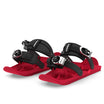
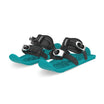
















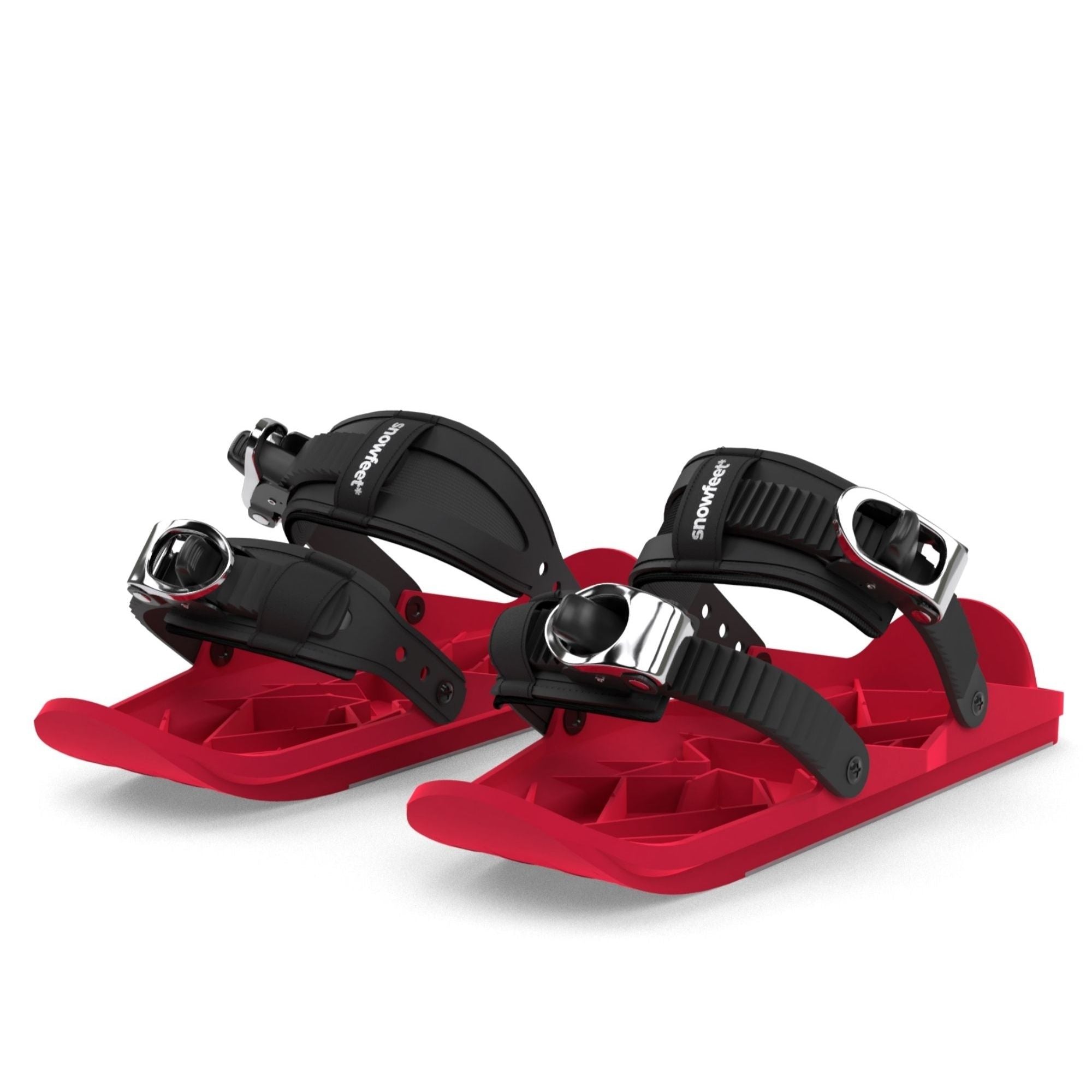
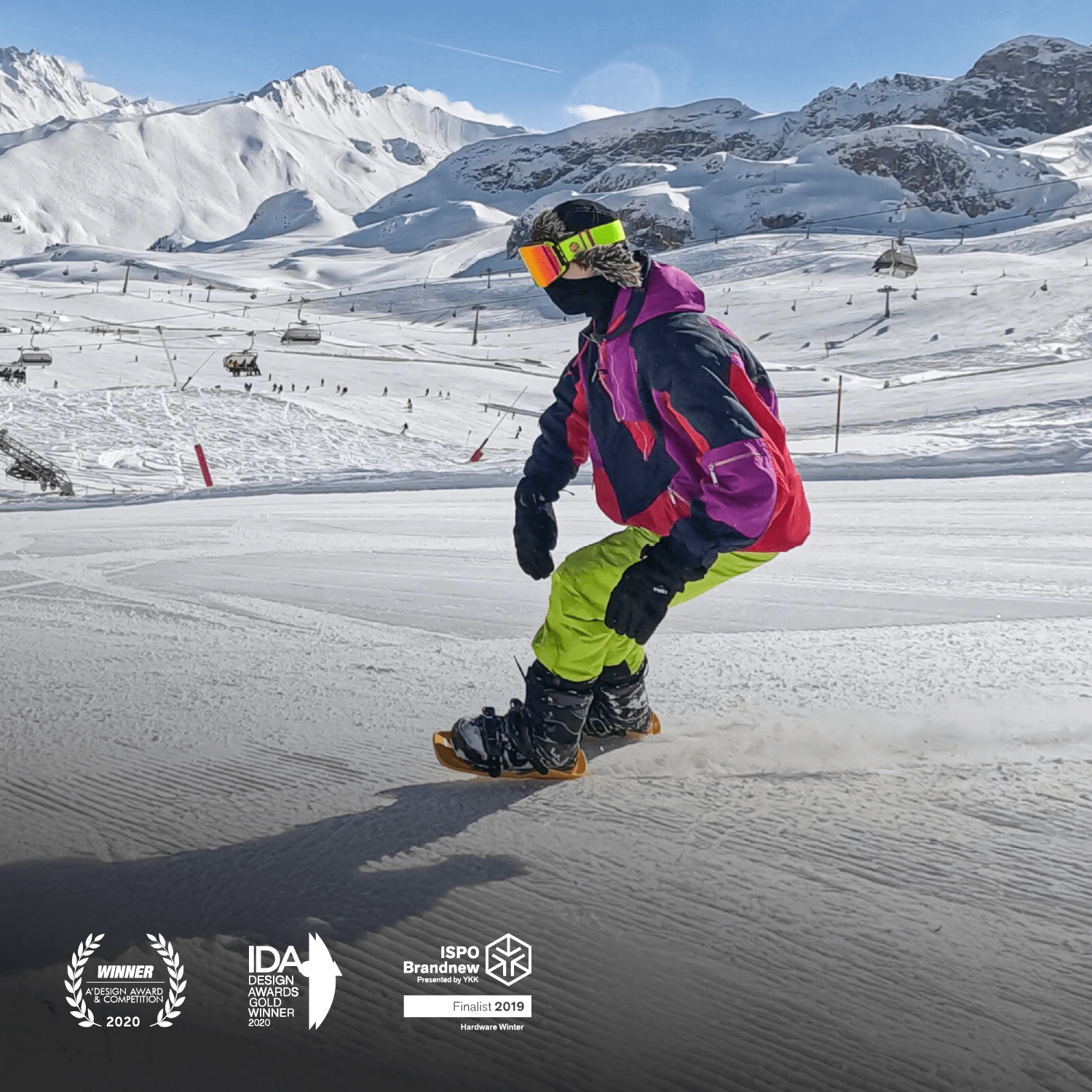




コメントを残す
このサイトはhCaptchaによって保護されており、hCaptchaプライバシーポリシーおよび利用規約が適用されます。